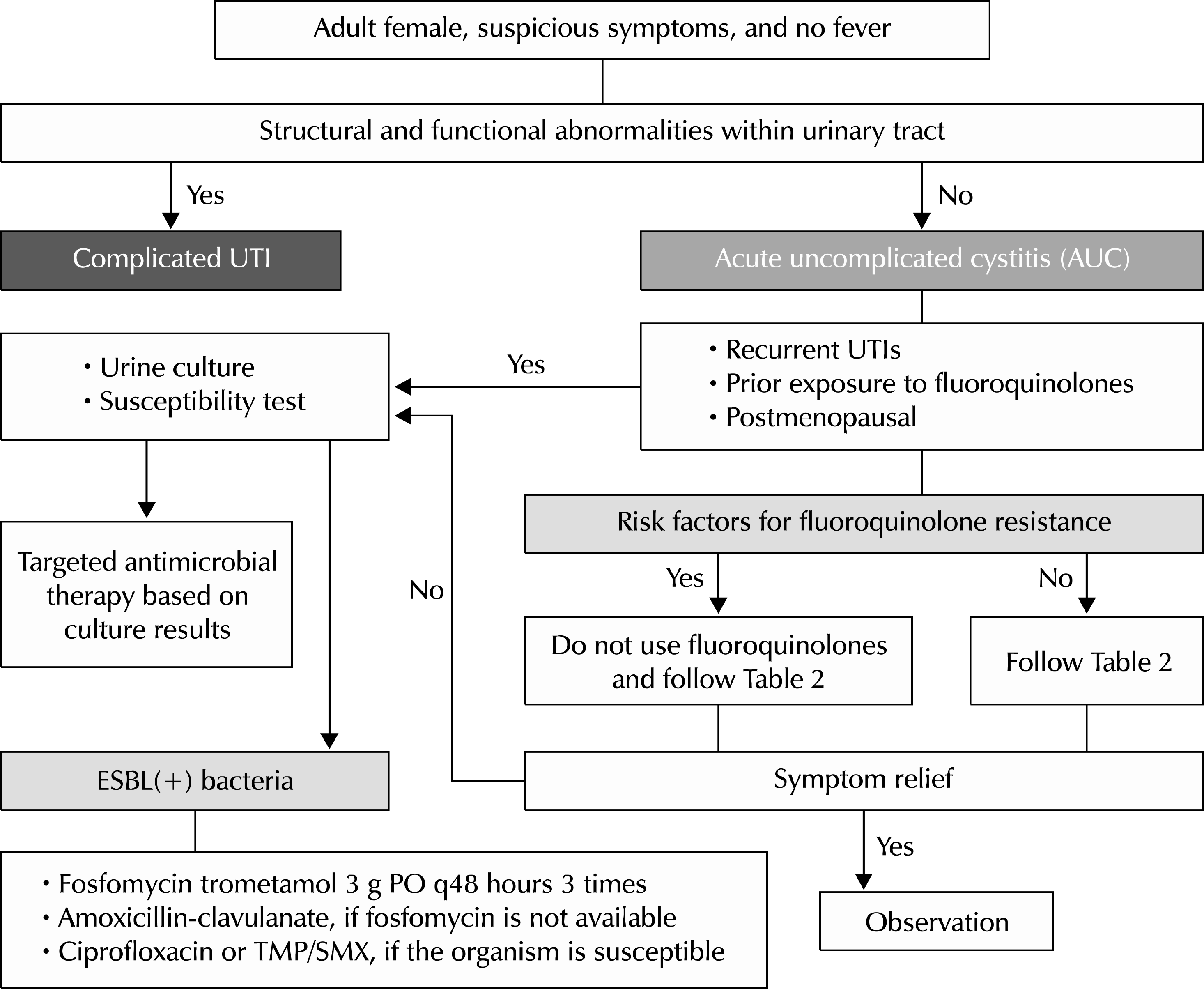Abstract
Acute uncomplicated cystitis is the most common urinary tract infection that mainly occurs in adult females, particularly sexually active young women and postmenopausal women. It is commonly observed in primary health care settings, including urology as well as obstetrics and gynecology; more than half of healthy adult women visit clinics and hospitals at least once in their lifetime due to acute uncomplicated cystitis. The most common bacterium causing this condition is Escherichia coli, followed by Staphylococcus saprophyticus, Klebsiella pneumoniae, Proteus mirabilis, and etc. Trimethoprim-sulfamethoxazole or fluoroquinolones have been used as an empirical antibiotic treatment. However, as fluoroquinolone-resistant organisms or extended spectrum beta-lactamase-producing organisms are becoming more prevalent worldwide, information on regional antibiotic resistance and guidelines on antibiotic use are becoming increasingly more desparate.
REFERENCES
1.Stamm WE., Hooton TM. Management of urinary tract infections in adults. N Engl J Med. 1993. 329:1328–34.

2.Bradbury SM. Collection of urine specimens in general practice: to clean or not to clean? J R Coll Gen Pract. 1988. 38:363–5.
3.Lifshitz E., Kramer L. Outpatient urine culture: does collection technique matter? Arch Intern Med. 2000. 160:2537–40.
4.Fihn SD. Clinical practice. Acute uncomplicated urinary tract infection in women. N Engl J Med. 2003. 349:259–66.
5.Foxman B., Brown P. Epidemiology of urinary tract infections: transmission and risk factors, incidence, and costs. Infect Dis Clin North Am. 2003. 17:227–41.
6.Gupta K., Hooton TM., Naber KG., Wullt B., Colgan R., Miller LG, et al. International clinical practice guidelines for the treatment of acute uncomplicated cystitis and pyelonephritis in women: a 2010 update by the Infectious Diseases Society of America and the European Society for Microbiology and Infectious Diseases. Clin Infect Dis. 2011. 52:e103–20.

7.Kim ME., Ha US., Cho YH. Prevalence of antimicrobial resistance among uropathogens causing acute uncomplicated cystitis in female outpatients in South Korea: a multicentre study in 2006. Int J Antimicrob Agents. 2008. 31(Suppl 1):S15–8.

8.Lee SJ., Lee DS., Choe HS., Shim BS., Kim CS., Kim ME, et al. Antimicrobial resistance in community-acquired urinary tract infections: results from the Korean Antimicrobial Resistance Monitoring System. J Infect Chemother. 2011. 17:440–6.
9.Rafalsky V., Andreeva I., Rjabkova E. Quinolones for uncomplicated acute cystitis in women. Cochrane Database Syst Rev. 2006 Jul 19. [Epub].DOI: doi: 10.1002/14651858. CD003597.pub2.

10.Gupta K., Hooton TM., Roberts PL., Stamm WE. Short-course nitrofurantoin for the treatment of acute uncomplicated cystitis in women. Arch Intern Med. 2007. 167:2207–12.

11.Nicolle LE. Pivmecillinam in the treatment of urinary tract infections. J Antimicrob Chemother. 2000. 46(Suppl 1):35-9; discussion. 63–5.

12.Gupta K., Stamm WE. Outcomes associated with trimethoprim/sulphamethoxazole (TMP/SMX) therapy in TMP/SMX resistant community-acquired UTI. Int J Antimicrob Agents. 2002. 19:554–6.

13.Warren JW., Abrutyn E., Hebel JR., Johnson JR., Schaeffer AJ., Stamm WE. Guidelines for antimicrobial treatment of uncomplicated acute bacterial cystitis and acute pyelonephritis in women. Infectious Diseases Society of America (IDSA). Clin Infect Dis. 1999. 29:745–58.
Fig. 1.
Algorithm for clinical management of acute uncomplicated cystitis (adapted from Asian Association of UTI & STI). UTI: urinary tract infection, ESBL: extended spectrum beta-lactamase, TMP-SMX: trimethoprim-sulfamethoxazole.

Table 1.
Criteria based on which to determine an empirical antibiotic therapy
Table 2.
Empirical antibiotic treatment of acute uncomplicated cystitis
| Antibiotics | Dosage (oral) | Duration (d) |
|---|---|---|
| Fosfomycin trometamol | 3 g qd | 1 |
| Pivmecillinama) | 400 mg tid | 3 |
| Nitrofurantoin macrocrystala) | 100 mg bid | 5-7 |
| -Lactams | ||
| Amoxicillin-clavulanate | 250/125 mg tid | 7 |
| 500/125 mg bid | ||
| Cefaclor | 250 mg tid | 7 |
| Cefdinir | 100 mg tid | 5-7 |
| Cefcapene pivoxil | 100 mg tid | 5-7 |
| Cefpodoxime proxetil Fluoroquinolones | 100 mg bid | 5-7 |
| Fluoroquinolones | ||
| Ciprofloxacinb) | 500 mg bid | 3 |
| 500 mg SR qd | ||
| Tosufloxacinb) | 150 mg bid | 3 |




 PDF
PDF ePub
ePub Citation
Citation Print
Print


 XML Download
XML Download